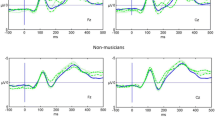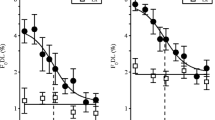Abstract
Previously, professional violin players were found to automatically discriminate tiny pitch changes, not discriminable by nonmusicians. The present study addressed the pitch processing accuracy in musicians with expertise in playing a wide selection of instruments (e.g., piano; wind and string instruments). Of specific interest was whether also musicians with such divergent backgrounds have facilitated accuracy in automatic and/or attentive levels of auditory processing. Thirteen professional musicians and 13 nonmusicians were presented with frequent standard sounds and rare deviant sounds (0.8, 2, or 4% higher in frequency). Auditory event-related potentials evoked by these sounds were recorded while first the subjects read a self-chosen book and second they indicated behaviorally the detection of sounds with deviant frequency. Musicians detected the pitch changes faster and more accurately than nonmusicians. The N2b and P3 responses recorded during attentive listening had larger amplitude in musicians than in nonmusicians. Interestingly, the superiority in pitch discrimination accuracy in musicians over nonmusicians was observed not only with the 0.8% but also with the 2% frequency changes. Moreover, also nonmusicians detected quite reliably the smallest pitch changes of 0.8%. However, the mismatch negativity (MMN) and P3a recorded during a reading condition did not differentiate musicians and nonmusicians. These results suggest that musical expertise may exert its effects merely at attentive levels of processing and not necessarily already at the preattentive levels.




Similar content being viewed by others
References
Alho K, Woods DL, Algazi A, Näätänen R (1992) Intermodal selective attention II: effects of attentional load on processing auditory and visual stimuli in central space. Electroencephalogr Clin Neurophysiol 82:356–368
Amenedo E, Escera C (2000) The accuracy of sound duration representation in the human brain determines the accuracy of behavioural perception. Eur J Neurosci 12:2570–2574
American Electroencephalographic Society (1991) American electroencephalographic society guidelines for standard electrode position nomenclature. J Clin Neurophysiol 8:200–202
Berti S, Schröger E (2001) Involuntary attention switch with different levels of distractor strenght. In: Sommerfeld E, Kompass R, Lachmann T (eds) Proceedings of the Seventeenth Annual Meeting of the International Society for Psychophysics. Pabst Science, Lengerich, Germany, pp 285–290
Besson M, Faïta F (1995) An event-related potential (ERP) study of musical expectancy: comparison between musicians and non-musicians. J Exp Psychol Hum Percept Perfor 21:1278–1296
Besson M, Faïta F, Requin J (1994) Brain waves associated with musical incongruities differ for musicians and non-musicians. Neurosci Lett 168:101–105
Brattico E, Näätänen R, Tervaniemi M (2001) Context effects on pitch perception in musicians and non-musicians: evidence from ERP recordings. Music Percept 19:199–222
Crummer GC, Walton JP, Wayman JW, Hantz EC, Frisina RD (1994) Neural processing of musical timbre by musicians, nonmusicians, and musicians possessing absolute pitch. J Acoust Soc Am 95:2720–2727
Escera C, Alho K, Schröger E, Winkler I (2000) Involuntary attention and distractibility as evaluated with event-related brain potentials. Audiol Neurootol 5:151–166
Fastl H, Hesse A (1984) Frequency discrimination for pure tones at short durations. Acustica 56:41–47
Kaernbach C (1991) Simple adaptive testing with the weighted up-down method. Percept Psychophysiol 49:227–229
Koelsch S, Schröger E, Tervaniemi M (1999) Superior attentive and pre-attentive auditory processing in musicians. Neuroreport 10:1309–1313
Kujala T, Alho K, Näätänen R (2000) Cross-modal reorganization of human cortical functions. Trends Neurosci 23:115–120
Münte TF, Altenmüller E, Jäncke L (2002) The musician’s brain as a model of neuroplasticity. Nature Neurosci Rev 3:473–478
Näätänen R (1992) Attention and brain function. Erlbaum, Hillsdale, NJ
Näätänen R, Simpson M, Loveless NE (1982) Stimulus deviance and evoked potentials. Biol Psychol 14:53–98
Näätänen R, Schröger E, Karakas S, Tervaniemi M, Paavilainen P (1993) Development of a memory trace for a complex sound in the human brain. Neuroreport 4:503–506
Näätänen R, Tervaniemi M, Sussman E, Paavilainen P, Winkler I (2001) ‘Primitive intelligence’ in the auditory cortex. Trends Neurosci 24:283–288
Näätänen R, Winkler I (1999) The concept of auditory stimulus representation in cognitive neuroscience. Psychol Bull 6:826–859
Novak G, Ritter W, Vaughan HG Jr (1992a) Mismatch detection and the latency of temporal judgements. Psychophysiology 29:398–411
Novak G, Ritter W, Vaughan HG Jr (1992b). The chronometry of attention-modulated processing and automatic mismatch detection. Psychophysiology 29:412–430
Novak GP, Ritter W, Vaughan HG, Wiznitzer ML (1990) Differentiation of negative event-related potentials in an auditory discrimination task. Electroencephalogr Clin Neurophysiol 75:255–275
Pantev C, Engelien A, Candia V, Elbert T (2001) Representational cortex in musicians: plastic alterations in response to musical practice. Ann N Y Acad Sci 930:300–314
Pantev C, Oostenveld R, Engelien A, Ross B, Roberts LE, Hoke M (1998) Increased auditory cortical representation in musicians. Nature 392:811–814
Pantev C, Roberts LE, Schulz M, Engelien A, Ross B (2001) Timbre-specific enhancement of auditory cortical representations in musicians. Neuroreport 12:169–174
Pascual-Leone A (2001) The brain that plays music and is changed by it. Ann N Y Acad Sci 930:315–329
Rauschecker JP (1999) Auditory cortical plasticity: a comparison with other sensory systems. Trends Neurosci 22:74–80
Rauschecker JP (2001) Cortical plasticity and music. Ann N Y Acad Sci 930:330–336
Ritter W, Paavilainen P, Lavikainen J, Reinikainen K, Alho K, Sams M, Näätänen R (1992) Event-related potentials to repetition and change to auditory stimuli. Electroencephalogra Clin Neurophysiol 83:306–321
Ritter W, Simson R, Vaughan HG, Friedman D (1979) A brain event related to the making of a sensory discrimination. Science 203:1358–1361
Sams M, Paavilainen P, Alho K, Näätänen R (1985) Auditory frequency discrimination and event-related potentials. Electroencephalogr Clin Neurophysiol 62:437–448
Schlaug G, Chen C (2001) The brain of musicians: a model for functional and structural adaptation. Ann N Y Acad Sci 930:281–299
Schröger E (1997) On the detection of auditory deviations: a pre-attentive activation model. Psychophysiology 34:245–257
Schröger E (1998) Measurement and interpretation of the Mismatch Negativity (MMN). Behav Res Methods, Instrum Comput 30:131–145
Shahin A, Bosnyak DJ, Trainor LJ, Roberts LE (2003) Enhancement of neuroplastic P2 and N1c auditory evoked potentials in musicians. J Neurosci 23:5545–5552
Sinkkonen J, Tervaniemi M (2000) Towards optimal recording and analysis of the mismatch negativity. Audiol Neurootol 5:235–246
Tervaniemi M, Rytkönen M, Schröger E, Ilmoniemi RJ, Näätänen R (2001) Superior formation of cortical memory traces for melodic patterns in musicians. Learn Mem 8:295–300
Tervaniemi M (2001) Musical sound processing: evidence from electric and magnetic recordings. Ann N Y Acad Sci 930:259–272
Tervaniemi M, Ilvonen T, Sinkkonen J, Kujala A, Alho K, Huotilainen M, Näätänen R (2000a) Harmonic partials facilitate pitch discrimination in humans: electrophysiological and behavioral evidence. Neurosci Lett 279:29–32
Tervaniemi M, Schröger E, Saher M, Näätänen R (2000b) Effects of spectral complexity and sound duration in complex-sound pitch processing in humans—a mismatch negativity study. Neurosci Lett 290:66–70
Tiitinen H, May P, Reinikainen K, Näätänen R (1994) Attentive novelty detection in humans is governed by pre-attentive sensory memory. Nature 372:90–92
Trainor LJ, Desjardings RN, Rockel C (1999) A comparison of contour and interval processing in musicians and nonmusicians using event-related potentials. Aust J Psychol 51:147–153
van Zuijen TL, Sussman E, Winkler I, Näätänen R, Tervaniemi M (2004) Pre-attentive grouping of sequential sounds—an event-related potential study comparing musicians and non-musicians. J Cogn Neurosci 16:331–338
Acknowledgements
The study was supported by Deutscher Akademischer Austauschdienst, Marie Curie Individual fellowship by European Commission (M.T.; QLK6-CT-2000051227) and DFG (E.S.).
Author information
Authors and Affiliations
Corresponding author
Rights and permissions
About this article
Cite this article
Tervaniemi, M., Just, V., Koelsch, S. et al. Pitch discrimination accuracy in musicians vs nonmusicians: an event-related potential and behavioral study. Exp Brain Res 161, 1–10 (2005). https://doi.org/10.1007/s00221-004-2044-5
Received:
Accepted:
Published:
Issue Date:
DOI: https://doi.org/10.1007/s00221-004-2044-5




